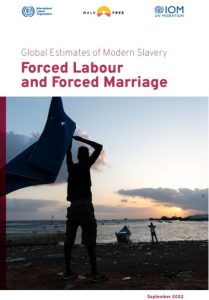Forced Labour & Forced Marriage – Global Estimates of Modern Slavery

Direct Link to Full 144-Page 2022 Publication:
Forced Marriage
As women and girls are disproportionately affected, legislative and policy responses should have a gendered lens, including gender-sensitive laws, policies, programmes, and budgets, including gender-responsive social protection mechanisms. It is important that these initiatives are inclusive, equitable, and provide non-discriminatory access to migrants. ▪ Ensure adequate civil and criminal protections in national legislation. This should include raising the legal age of marriage to 18 without exceptions in order to protect children, criminalizing the act of marrying someone who does not consent, regardless of age, and civil protections that protect the individual[1] from marriage without having to penalise the perpetrators, who are often family members. Legislative action should be part of a broader holistic response that tackles underlying drivers of forced marriage, and includes prevention and support measures such as safe accommodation, emergency funds, and psychosocial support. ▪ Address underlying socio-cultural norms and structures that contribute to forced marriage. Legislation is not in itself sufficient to end forced marriage[1] and needs to be combined with wider preventative approaches addressing[1] underlying discrimination and gender inequality, as well as related socio-cultural norms. Central to changing these attitudes is context-specific research on vulnerabilities and community-based education, training, and empowerment activities.
Извор: WUNRN – 21.10.2022


